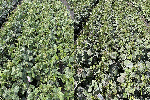GRDC invests in plant pathologists and pre-breeders who collect and analyse data from the National Variety Trials to create NVT disease resistance ratings.
Plant pathologists carry out disease screening services as part of the National Variety Trials (NVT) to provide growers with independent disease ratings on new varieties.
Through a network of plant pathologists supported by the NVT, soon-to-be-released varieties are screened for a range of diseases in different environments.
The results of this critical work are passed on to growers via the NVT website and publications, enabling crop varieties to be selected based on their resistance to disease.
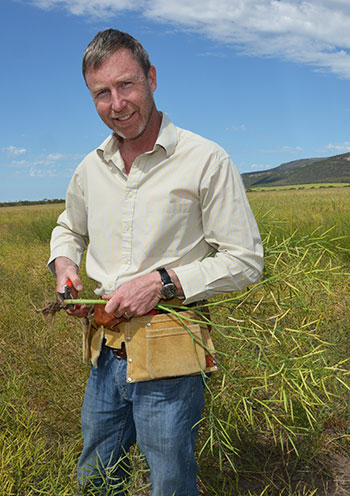 Blackleg resistance groups developed by Dr Steve Marcroft and colleagues are providing an additional tool for those in areas of intensive canola production. Photo: Emma Leonard/GRDC
Blackleg resistance groups developed by Dr Steve Marcroft and colleagues are providing an additional tool for those in areas of intensive canola production. Photo: Emma Leonard/GRDC
Steve Marcroft
Marcroft Grains Pathology
1. Where are you located?
Horsham, Victoria.
2. What crop do you research?
Canola.
3. What is the most pressing disease?
Blackleg.
4. How does the NVT help?
We develop blackleg ratings for NVT in canola using eight disease nurseries across Australia. All commercial varieties and cultivars two years before release are included.
With the NVT yield trials, we use 32 sites across Australia’s canola-growing regions to monitor evolving blackleg populations to enable regional-specific advice.
5. What’s the benefit of it?
An independent service to test canola for blackleg is critical, enabling growers to choose cultivars with major blackleg resistance genes.
6. What would growers do if this information did not exist?
Canola cannot be grown without blackleg resistance, and the industry is unlikely to have developed without blackleg ratings. The blackleg pathogen evolves quickly, so cultivars lose resistance, which is why some can only be used for three years. Without the NVT, growers could not access regional advice about canola’s resistance to blackleg.
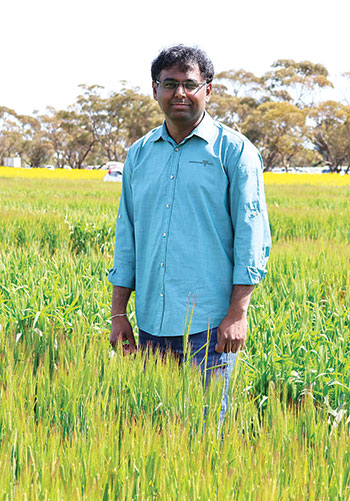 Dr Hari Dadu manages Agriculture Victoria’s cereal disease program. Photo: Luise Fanning
Dr Hari Dadu manages Agriculture Victoria’s cereal disease program. Photo: Luise Fanning
Hari Dadu
Agriculture Victoria
1. Where are you located?
Agriculture Victoria’s Horsham SmartFarm.
2. What crop diseases do you research?
Cereal (wheat, barley and oats) diseases.
3. What is the most pressing disease?
Stripe rust. It can cause severe grain yield losses if left uncontrolled.
4. How does the NVT help?
It enables growers to see how released and yet-to-be-released varieties hold up regarding resistance. We identify the most disease-resistant varieties according to region.
5. What’s the benefit from it?
Growers can select disease-resistant varieties based on resistance ratings. Growers can better develop a management strategy for disease based on the disease rating.
6. What would growers do if this information did not exist?
Fungicides may be overused, leading to resistance, reducing the tools available to growers, and lowering yields.
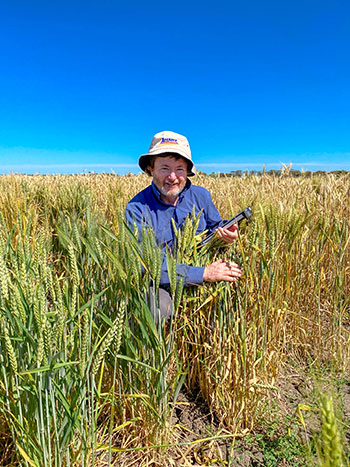 Astute Ag senior consultant Dr Grant Hollaway worked on the NVT for many years in his former role at Agriculture Victoria. Photo: Supplied Grant Holloway
Astute Ag senior consultant Dr Grant Hollaway worked on the NVT for many years in his former role at Agriculture Victoria. Photo: Supplied Grant Holloway
Grant Hollaway
Astute Ag
1. Where are you located?
Horsham, Victoria.
2. What crop diseases do you research?
Cereal diseases.
3. What is the most pressing disease?
Rust.
4. How does the NVT help?
The NVT is essential when communicating with growers about disease management. It gives growers the confidence not to apply fungicide if the variety they select has adequate genetic resistance.
5. What’s the benefit of it?
The NVT disease ratings are critical for helping growers select varieties resistant to various diseases and determine the required in-crop or fungicide management level.
6.What would growers do if this information did not exist?
Without the NVT, disease management would be more challenging. Growers would not know the resistance of various varieties to disease, and fungicides would likely be applied equally to resistant and non-resistant varieties.
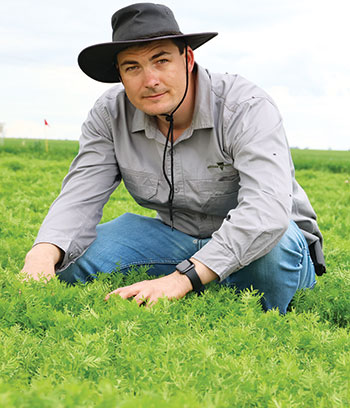 Agriculture Victoria senior research scientist Dr Joshua Fanning. Photo: Agriculture Victoria
Agriculture Victoria senior research scientist Dr Joshua Fanning. Photo: Agriculture Victoria
Joshua Fanning
Agriculture Victoria
1. Where are you located?
Agriculture Victoria’s Horsham SmartFarm and AgriBio Centre for AgriBiosciences in Bundoora.
2. What crops and diseases do you research?
I work on soil-borne diseases in lentils, faba beans, chickpeas, vetch, field peas, lupins and cereals.
3. What are the most pressing diseases?
Botrytis grey mould and chocolate spot in lentils, faba beans and vetch, as there are only a few resistant varieties.
4. How does the NVT help?
The NVT provides standardised varietal disease ratings. Varietal resistance is one of the main building blocks for a robust integrated disease management plan.
5. What’s the benefit of it?
The NVT offers a standard rating process and definition across the disease by crop combinations. With correct ratings, it provides a standard communications approach for disease management. It identifies the risk that a variety will succumb to disease, which allows a disease management plan to be developed.
6. What would growers do if this information did not exist?
Our disease management plans would be a guess. We would have to treat all varieties as susceptible and apply more fungicides than necessary, likely leading to more fungicide resistance.
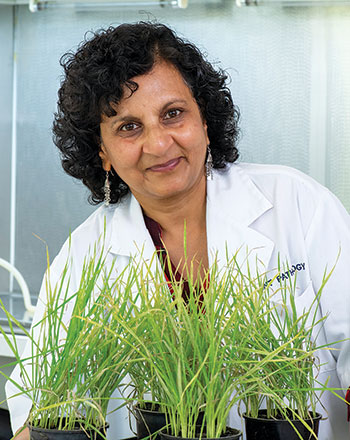 Dr Manisha Shanker is a senior Western Australian Department of Primary Industries and Regional Development plant pathologist. Photo: WA DPIRD
Dr Manisha Shanker is a senior Western Australian Department of Primary Industries and Regional Development plant pathologist. Photo: WA DPIRD
Manisha Shanker
Western Australian Department of Primary Industries and Regional Development
1. Where are you located?
South Perth, Western Australia.
2. What crops and diseases do you research?
I work as a plant pathologist and pre-breeder on wheat and oats. The diseases I research are yellow spot, Septoria nodorum blotch and powdery mildew.
3. What is the most pressing disease?
Yellow spot.
4. How does the NVT help?
The NVT accurately estimates resistance to various diseases and pathotypes in commercial and breeding material regionally and nationally.
5. What’s the benefit from it?
The NVT plays a crucial role in monitoring the effectiveness of resistance genes in varieties. This information is essential for breeders, pre-breeders and growers when selecting disease-resistant varieties.
6. What would you do if this information did not exist?
If we did not have access to disease resistance information through the NVT, we would have to develop a research program to know what varieties to choose for developing populations for pre-breeding and monitoring various pathogens.
More information: Steve Marcroft, 0409 978 941, steve@grainspathology.com.au; Hari Dadu, 0456 665249, hari.dadu@agriculture.vic.gov.au; Grant Hollaway, 0493 030 980, grant.astutueag@gmail.com; Joshua Fanning, 0419 272 075, joshua.fanning@agriculture.vic.gov.au; Manisha Shankar, 0407 003 183, manisha.shankar@dpird.wa.gov.au































